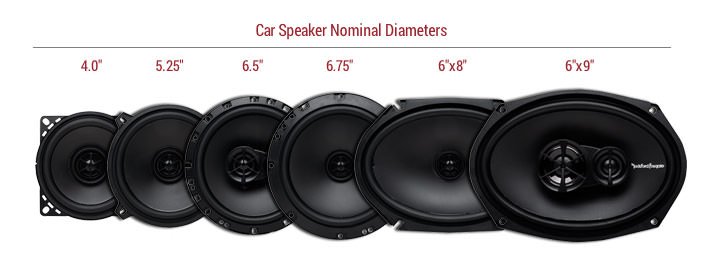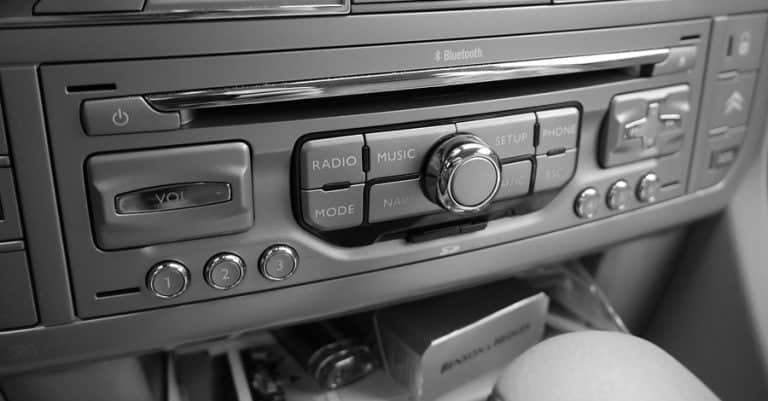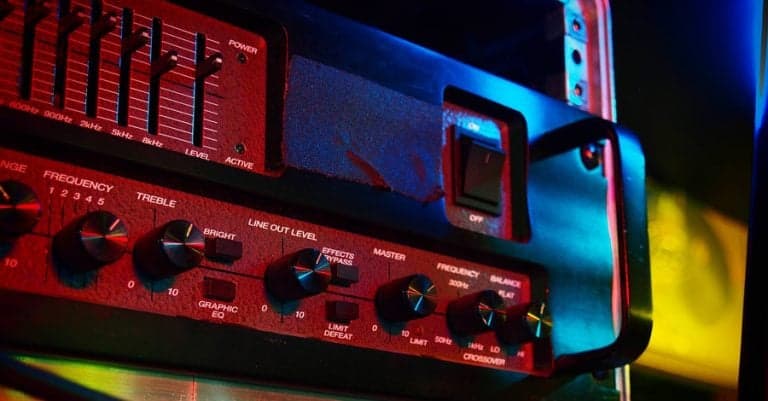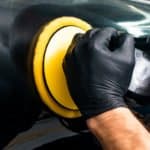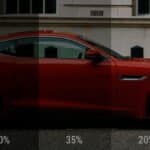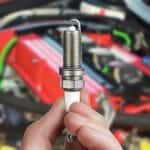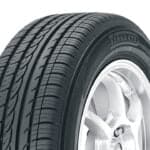Affiliate Disclosure: Some of the links in this post are affiliate links. As an Amazon Associate, we earn from qualifying purchases. Read more in our affiliate policy.
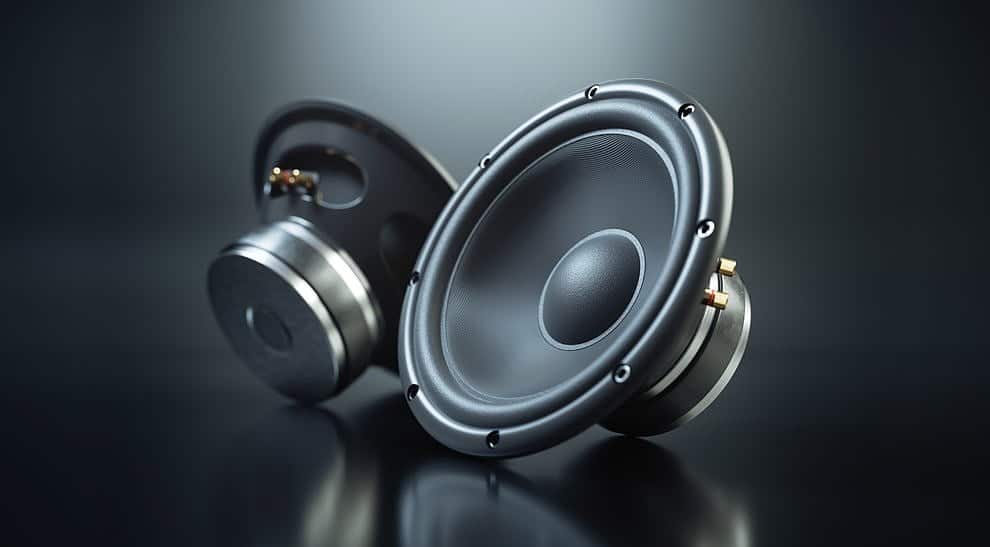
Best Car Speakers – Top Picks To Rock the Block (With Reviews)
One of the first things that people like to do when they get a new car is amp up the stereo system. Some people want to be able to blast out their tunes, while others are looking for high quality components to provide the best quality listening experience when they are on the road. While not everyone may agree on the same end goal for having the best car speakers, most can agree that the best car audio speakers are not the ones that come standard in most any car.
A search for the best speakers for a car can be a long involved one. Luckily, GarageChief.com have done most of that research for you. We have rounded up seven of the best options on the market today for you to look through.
But even that might not be enough to get you totally set up with the right speakers. We have also added a buyer’s guide to help you make sure you track down just the right speakers for your set up.
Best Car Speakers – Our Top Picks Compared
| editors-choice | Best Product | Best Value | ||||
|---|---|---|---|---|---|---|
| item-title | Alpine SPR-60C 6.5" Car Audio Component System | Polk Audio DB651 6.5"/6.75" 2-Way Speakers | Rockford Fosgate R165X3 Prime 6.5-Inch 3-Way Coaxial Speaker | Pioneer TS-A6985R 6" x 9" (6x9) 4-Way TS Coaxial Car Speakers | JBL GTO 629 Premium 6.5-Inch Co-Axial Speaker | Infinity Kappa 62.11I 150W 6.5-Inch 2-Way Coaxial Speakers |
| • Frequency Response: 65Hz - 29kHz • Sensitivity: 87 dB • Peak: 660 watts per set | • Power Handling: Peak: 360 watts per pair • High Pass and Low Pass Crossover Filters • Polymer composite Dome Tweeter | • Vacuum polypropylene cone • Silk dome pole mounted piezo tweeter and midrange • Integrated tweeter Crossover | • Power Handling: Peak: 550 watts per pair • Multilayer Mica Matrix cone material • Elastic Polymer speaker surround | • Patented UniPivot tweeter allows you to aim the sound at your ears • A dual-level tweeter volume adjustment • Dedicated 12dB/octave | • 6-1/2" Kappa Series 2-Way Car Speakers • Power Handling: Peak: 450 watts per pair • Carbon Injected Glass Fiber cone material |
|
| td-btn-amz | Check Price at Amazon | Check Price at Amazon | Check Price at Amazon | Check Price at Amazon | Check Price at Amazon | Check Price at Amazon |
| editors-choice | Best Product | Best Value |
Car Audio Speaker Reviews
When searching for the best car speakers there is a lot to consider. With any number of companies out there offering you their speakers you need to look at the hard facts and numbers. If you get a chance after you have narrowed down your list to a few top contenders listen to what each sounds like.
Remember, that in a show room everything will be tweaked to give you the best possible experience, driving your car down the road might not give you the same level of performance.
We have come up with a list of 7 great contenders. Each of them could be a great choice, so you’ll have to pick the one that matches your needs the best.
Alpine SPR-60C Type-R 6.5″ Car Audio Best Component Speakers
We’ll start off with the best set up that we have found. The Alpine SPR-60C 6.5” Car Audio Component System speakers are pair of tweeters for a vehicle with a component system ready to go. You’ll need to pair this with a separate woofer to give you that rumble of bass, but these will get you those great high ends that sound so good. As far as power handling these are rated at an RMS of 220 Watts for the pair or 110 Watts for each speaker. With a sensitivity of 87 dB you have a very good set up on your hands.
The frequency response of these speakers is stunning, going all the way from 65 Hz to a stunning 29 kHz. Which covers more than what many consider the range of human hearing to be. If you are going for the full audio upgrade these are the speakers that you will want to have in your car as you are driving around jamming out to your tunes. At just shy of $170 these may not be for everyone, but we feel they are the best on the market.
Rockford Fosgate Prime 6.5-Inch Full-Range 3-Way Coaxial Speaker (R165X3)
If you are looking to upgrade your car’s audio system but are trying to stick to a budget we feel that you can’t go wrong with the Rockford Fosgate R165x3 Prime Full-Range 3-Way Coaxial Speaker. Being a Coaxial speaker this pair packs a tweeter, a midrange and a woofer all into one package to give you all the sound that you need to experience your music. And what is rather stunning, they do it for under $35 dollars. As far as power handling this one is rated at an RMS of 45 Watts and its sensitivity is 91 dB.
This set up features a frequency response range of 52 Hz all the way up to 20 kHz, which is again a bit more than the normally accepted human auditory range. This speaker set up even has an integrated crossover set up to provide for the crispest of sounds coming out of them. When you take everything that Rockford has packed into this pair of speakers and compare it to the price there is no wonder that we picked these as our best value option.
Polk Audio DB651 6.5″/6.75″ 2-Way Marine Certified db Series Car Speakers with Liquid Cooled Silk Tweeters
If you are looking for a top end 2-way speaker you’ll want to check out the Polk Audio DB651 2-Way Marine Certified Car Speakers. Perhaps the most striking feature of these speakers is their look. They sport a gold looking cone that is the silk cone of their set up. But it sports a secret, it is a liquid cooled silk/polymer composite. When it comes down to numbers these speakers are still quite impressive.
The pair of speakers are rated at a power handling RMS of 120. These also sport a full rubber surround that will give better performance over a longer lifespan. Polk has made this system simple to install. They have a multi-hole mounting set up, so no matter how many mounting points you need to use there should be one ready. They have also crafted the speaker to have a shallow depth to allow it to fit in more places.
Also, these speakers have been certified for use in marine settings. That includes being able to handle temperature swings from -40 all the way to 185 F. Unless you frequently find salt water in your car these are sure to have quite a long life providing high quality music for your enjoyment.
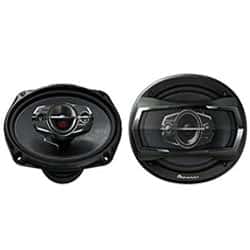
Pioneer TS-A6985R 6×9″ 4-Way TS Coaxial Car Speakers
The 6 x 9 speaker is a very common size and there is a fair amount of competition to be the king of this mountain. However, we think that the Pioneer TS-A6985R 4-Way TS Coaxial Car Speaker is the winner here. There is additionally a 3-way model, but why not go for the top dog when it comes time to upgrade your speakers to the best car speakers on the market. This set is rated for a power handling RMS of 100 Watts each.
The cone for this set up is made of a micra matrix to be lightweight enough to be responsive while still being stiff enough to provide amazing sound. This is a set of speakers that will really put out a nice quality sound. One downside though is that the 4-way option has been discontinued by Pioneer.
They still make the 3-way option though. If you really want the 4-way you should still be able to track down a pair from some companies. This one will run you between $70 and $130.
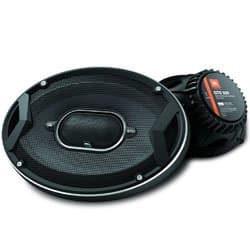
JBL GTO 629 Premium 6.5 Inch Coaxial Speaker
For some people the best speakers for a car are the ones that can put out the best bass. If you are looking for that in a coaxial speaker you should take a good look at the JBL GTO 629 Premium Co-Axial Speaker. These sport a carbon injected cone that is larger than other cones in the same class of speaker.
As a speaker gets a larger cone it is able to move more air around it. This ability results in being able to produce a better bass sound. The tweeters have a volume adjustment in them. This means that you can tweak your levels and overcome less than ideal speaker placement and still end up with a quality sound when it gets to your ears.
As far as RMS value for power handling is 60 Watts. These produce a very clean and crisp sound when properly installed. The highs and even the midrange sounds quite remarkable. The pair of them comes in just under $75, so while they are not the cheapest on the list, for the performance that you will get out of them they are still a very good deal. These also sport a dedicated 12 dB crossover, this ensures that the correct speaker will play the right range of music giving you a better sound quality.
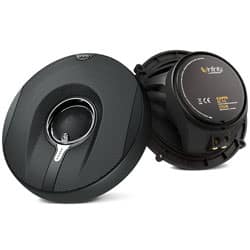
Infinity Kappa 62.11I 150W 6.5″ 2-Way Kappa Series Coaxial Speakers
Based on our investigation of the subject, we feel that the best coaxial speakers are the Infinity Kappa 62.11i Kappa Series Coaxial Speakers. These babies sport a carbon injected glass fiber cone that results in some fantastic performance in pushing out that thumping bass that most people are after.
They also come standard with a one inch soft dome tweeter to cover those higher ends and still give you amazing sound. As fair as power handling, these are rated at an RMS of 150 Watts for the pair, or merely 75 Watts per speaker.
This pair of speakers not only has the ability to provide outstanding sound while you are cruising down the road, but they also pull off something else that not all quality speakers do. These look cool. When you swap out your factory speakers not only will you notice a bump in the tunes coming out of these can get your car interior looking sweet. Additionally the midrange coming out of these speakers is just awesome.
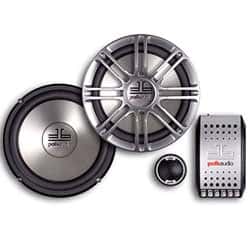
Polk Audio DB6501 6.5-Inch 2-Way Component System
If you are looking for the best component speakers that can straddle the gap, working excellent with both factory, low power, stereos or after market, high power, stereo set ups, you owe it to yourself to look at the Polk Audio DB6501 2-Way Component Speakers.
These are a set that look stunning with or without their grill and provide some outstanding audio as well. The pair sports a tweeter crafted from a liquid cooled silk/polymer domed tweeter that have the ability to swivel, letting you optimize the sound stage of your vehicle. They also have a 6.5 inch woofer for those stunning lower end sounds.
As this system has been certified for marine use and all of the wear and tear that comes with it, they are sure to stand up to most any abuse that you might dish out while they are installed in a car.
One of the nice touches that Polk Audio has added is that they have a full rubber surround where many companies only use a foam surround. The rubber gives a better quality sound, but over the long run it will hold up better, meaning that your speakers should not only sound great when you first get them installed, but also in a number of years down the line.
Best Car Audio Speakers – The Practical Buyer’s Guide
Looking to improve your car’s audio? Start with the speakers
Let’s face it, unless you paid a boatload of extra money for to upgrade your car’s audio system when you got it new, you could probably have a better audio experience in your vehicle. Even if you did spend all that money and your car is five or more years old, there is probably some better options on the market.
But where to begin to even look at your audio options? Audio engineers can obsess about various numbers and measurements and the like, but what does it all mean to you? After all, who cares if it goes up to 11 if it doesn’t sound good while you are driving? We’ll cover everything that you need to know in the paragraph’s below.
Car Audio Speakers Basics
There is quite a bit to know when it comes to car speakers and you could easily take a course on the subject. But for general information, perhaps the most important thing to keep on your mind during this whole process is to match your speakers.
The first level might seem easy enough, with a stereo system your speakers come in pairs and as such you want both speakers to match one another providing an even sound throughout the entire car. However, there is more to it than just that. You need to match your speakers to your car’s stereo as well. The best 6.5 car speakers won’t provide great sound if they are matched with an old worn-down tape deck.
Speaker Materials
As you might expect the materials that your speakers are crafted from have a major effect on how your system sounds. To make the matter more complicated different style speakers will generally be crafted from different materials. Even in a given type of speaker there is no simple “best material” out there.
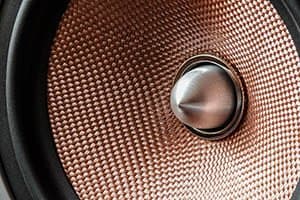
For a woofer you want that strong bass, so you need a material that is stiff but still lightweight enough to give a full range of sound. For most woofer cones you will find a material like polypropelene or a similar synthetic material. Often times these materials are mixed with something stiffer like a metal to provide a richer sound coming from a stiffer speaker cone.
A woofer is tricky since to get the best sound you not only need a speaker but also a surround. This lets the speaker cone move and give you better audio quality. Not just any material can do it though, since this is in your car it can come up against extremes in both heat and humidity. The hands down best option is to go with a rubber surround. If you are looking to save some money you can get some good performance out of foam rubber though.
Speaker Design Types
Over all you have two main options when it comes to speaker designs that are fit for car audio options. The first is the full-range speaker and the second is the component. Both of these have their pros and cons, which you go with will probably be influenced by who is installing them, how much space you have and the budget you are looking at.
-
Full-Range Speakers
The first option is the full-range speaker, sometimes called a coaxial or 2- or 3-way speaker. A style of this is probably what is in your car right now. These speakers will provide the whole range of sound in a single package. This means that they will take up less space in your car and generally be cheaper. Additionally, since the whole thing is in one package they tend to be easier to install if you are looking to DIY the install.
The speaker itself will consist of a tweeter, for the high range, a mid-range speaker and a woofer, for the low range, in a 3-way speaker. A 2-way speaker will simply have the tweeter and the woofer. They will be arranged so that the tweeter (and the mid-range if there is one) will partially block the woofer.
While this set up saves on space, you won’t get the top sound quality out of this style of system. That isn’t to say you can’t get some amazing sound out of high-quality full-range speakers.
-
Component Speakers System
A component speaker system is, as the name implies, separate speakers that work together to cover the full range of sound. These will end up providing a higher quality sound for your ride, but they have their downsides as well. The first being that this method of picking speakers is going to be more expensive.
Additionally, since each speaker is a unit to itself you have to find different places to put each one. If you just go with tweeters and a woofer you can probably put your tweeters in the door where your current speakers are and often people will place a woofer somewhere in the back, like in the trunk.
More speakers means that installation will either take more of your time or will run you a higher bill. It will be up to you to determine if the added sound quality is worth the added expense.
Main Parameters
-
Design Sensitivity (dB)
The first thing to consider is the design sensitivity, this one is measured in a unit called decibels. The easy way to look at this is how loud your speaker will be when it is powered. The tricky thing here is you have to look at more than just big number good.
You need to concern yourself with the car’s stereo power. Most factory installed systems are a low power set up, normally 15 Watts per channel or less. In this case you will find that average speakers come in around 87 to 88 dB, if you find one rated over 90 it is excellent.
If you have a high power system, generally an aftermarket set up, that is powered by an amplifier, normally 16 Watts per channel, you’ll actually want to look at a speaker with a lower sensitivity setting. There is no need to worry, in this set up if everything is properly powered you will still end up with amazing sound.
-
Power Handling
Power Handling in a speaker system is measured in watts and is truly how much power a given speaker can handle. There are some things to be aware of here to make sure that you compare speakers fairly though. The first thing to note is that you can have a power handling number labeled peak and another labeled RMS.
GarageChief TIPAlways compare RMS numbers when looking at speakers.
The peak number is the maximum power that your chosen speaker can handle. It is less useful than RMS, as this tells you how much power the system can work with on a continual basis. You should always compare RMS numbers when looking at speakers.
But again, here you have to consider if you have a high or low power system. A low powered system does not require a set of speakers with a very high RMS handling ability. On the other hand, if you have a high powered system you will want to match your power handling numbers to the amount of power that the amps in your set up put out.
-
Nominal Impedance (Ohms)
Impedance can get very complicated very quickly. First off you should know that it is measured in Ohms. Very generally this is the amount that your speaker will restrict the amount of current flowing through it. It is labeled nominal since this is the “general value” of a given speaker, the actual impedance is more complicated to come up with.
Impedance needs to be matched to the power of the system, as going too high or too low can result in either poor sound or in the worst case your system burning itself out.
-
Frequency Response (Hz)
Frequency Response is measured in Hertz. This is a measure of the frequencies that your speakers will be able to put out. Normally this will be given in a range. Most of the time you will see that range as going from 20 Hz to 20 kHz. This is generally considered the range of what the human ear can hear, with the low end being your bass sounds and your high end being the treble notes.
As a note though, depending on the source of your music your speakers may not have anything to fill sections of that range. Some formats of music compress their files and leave out certain ranges if they creators thing that most people won’t really miss that area of the spectrum, this is done to save storage space.
Before you discount a speaker that doesn’t claim to cover that full range, be sure that your stereo and music will actually need the full available range. If not you may be able to save some money.
-
Crossovers
Some full range speakers will simply run a wire to each part of the speaker and they will all try to make the full range of sounds. This means that your tweeters will be putting out some bass and the woofer will be putting out some of the high end. Frankly, they won’t do a great job at it.
On a higher end full-range speaker you’ll find crossover (if you don’t you can get one here). This will help out by essentially filtering the input to each speaker. It makes sure the speakers are only producing the range they were made for. You’ll find that with this style of set up your sound comes through much cleaner and will sound more crisp.
-
Dimensions
These are perhaps some of the easiest numbers to understand when it comes to car speakers. They will let you know how much space you need in order to properly install your new speakers. The first number that you’ll find is the nominal diameter. This will let you know about how big across it is. This one is labeled nominal as you’ll no doubt find some small levels of fluctuations in each speaker.
The next is the mounting depth. This lets you know how far back the speaker will go. This will tell you if your car door is deep enough to hold the speaker or if you need to start searching for a new mounting solution.
With these two bits of information you’ll be able to track down a great spot for your speaker where you know it will fit.
-
Warranty
GarageChief TIPAs for the installation, it’s worth to hand off the project to a professional making sure the job gets done right the first time. Google a recommended service in your area or try the Amazon’s In-Store Installation Service.
Of course, you will want to make sure that you have a warranty on any larger investment and new speakers are no different. This lets you know that the company is willing to stand behind their product. There are some things that you will need to consider. First, no warranty on speakers will cover incorrect installation, if you DIY it and hook things up wrong then blow out your speakers no company is going to pick up the tab for you.
Second, not all warranties are the same. You will want to consider the time frame that the warranty covers as well as its conditions. This shouldn’t be the main thing that helps you pick a speaker set up, but if you have two sets that seem equal everywhere else it might just be the deciding factor.
-
Other Extra Features
Now a days speakers can do all sorts of different tricks. One such trick comes from a pivoting or swiveling tweeter. A bass will put out sound in all directions, this means that even if it is in your trunk you can still get a great bass sound out of your system. A tweeter on the other hand is much more directional. If you ever go to an electronics store and see their test area for speakers there is most likely a specific spot they want you to stand, that is where all the tweeters are aimed.
A tweeter can pivot or swivel though, so instead of being aimed straight ahead of the speaker you can direct that sound in a different direction. This means that instead of your feet getting the best audio quality you can point it up to your ears, where it will do a little more good.
One other feature to consider in the best car speakers is detachable speakers. This style of speaker comes as a full-range speaker but then you can pop the components apart and install them separately. This is a great choice if you feel that you will end up moving them from one car to another or if you might want to change your speaker layout in the future.
Matching Car Speakers to Your Audio System
As we mentioned above you need to make sure that your stereo system in your car will work well with the speakers you put in. There are a number of things that all need to match up when pairing the two. First you will want to consider the frequency response.
You’ll be on the safe side if you get one that covers the whole 20 Hz to 20 kHz range, but if you know that your stereo only puts out some of that range you can get a speaker set that should match it.
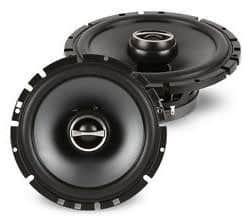
Most factory installed systems are low power set ups. If you have an after-market stereo or you have an amp in your sound system that is a good sign that you have a high-power system. In general, a low power set up will give 15 Watts or less per channel. A high-power system can do 16 Watts per channel.
In a low-power set up you won’t need a very high value in terms of your RMS power handling. For your speaker’s sensitivity, if you find something that is 90 dB or higher you are in great shape.
The opposite is true in a high-power system. For this set up you can go with a lower sensitivity but you will need to match your RMS power handling to the power your amp is going to be pumping out.
Failure to properly match up your speakers with your stereo will result in problems. If you are luckily you will only end up with poor sound quality. If not you can blow out your speakers and possibly burn out your amp.
Matching Speakers to Your Vehicle – Check the Size!
Once you have found a set of speakers that you like the look and sound of, you still have work to do. Even once you have made sure that your sensitivity and power handling will work you still need to make sure the speaker will actually fit in your car.
One of the problems that you will find here is that the numbers can be rather tricky to wrap your head around. This is a space when if you see 2×4 it doesn’t mean exactly 2 inches by 4 inches.
First you will have the nominal diameter. This lets you know about what size speaker you are getting, but not necessarily the exact dimension. Each manufacturer will have their own true size for a given nominal speaker size.
Second you need to consider the depth. There is a mounting depth and a mounting height. The depth is how far back from the attachment a given speaker needs. The height is how far from the mounting point the speaker will go forward. Since most cars will have a guard over the tweeter to make sure that you have enough room to cover both the height and depth for your speaker choice.
Additionally, you need to look at the mounting configuration. Some speaker set ups have a full flange all the way around them with slots to mount them in place. Others have protrusions out at the mounting points. You also need to know how many holes your set up has to mount, some will have 3, others 4 and some are considered multi-hole with enough that you can use either set up.
How Hard is it to Install Car Speakers?
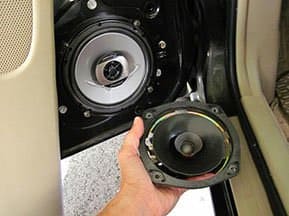
If you feel comfortable with this then a simple swap of one speaker for another isn’t that hard to accomplish. You will of course want to remember to ensure that you have everything properly connected and tested before fully reassembling.
If you are looking to go from a set of coaxial speakers to component speakers you may have your work cut out for you. You’ll need to not only take out the old ones, which will provide spots for some of the speakers, but you’ll have to find homes for and mount the other speakers. Don’t forget that you will need to run wires to these new ones as well.
As always, remember to disconnect your battery first! It’s easy to blow out your speakers or burn out your amp.
Speaking of wires, you might need to replace them during your install. If you have a newer car and are sticking with a low power stereo to properly matched speakers you shouldn’t have any issue. However, if you are putting newer speakers into an older car or working with a high-power system you might find the current wiring insufficient for your needs.
There are many videos to walk you through the exact process based on the speakers you have selected and the type of car that you are working on. Be sure to review the process before you begin and make sure that you have all the tools you need (a set of screwdrivers is a necessary minimum).
What are the Best Car Speaker Brands?
Whenever you are looking to make a purchase it is normal to want to go with a name brand. Normally this means a higher quality product, but it can also mean a bigger price tag. There are some names out there that are very well known and provide a great quality. There are some other little known brands that still make a great product, but they can be harder to find.

Polk Audio Speakers
Polk speaker are a very high quality brand and normally with these speakers you can feel the music almost as much as you can hear it. They offer quite a range of price points for their speakers. Some can be found for just north of $50, while others can climb up to $200 or more per speaker. These are speakers designed by people that really love their music.

Pioneer Car Speakers
Pioneer is a brand that makes just about any kind of audio component that you could hope to find. And even more so they tend to be good quality at a good price. Often you can find most of pioneer speaker offerings for less than $50. They have some good quality, but aren’t going to be the top of the line offerings.

JBL Car Speakers
JBL is a company that has been known for putting out some outstanding quality speakers. While they can run from around $100 to several hundred for their speakers. The quality of sound you get from them tends to be rather great. Some car companies even use these speakers as their upgraded sound system.

Infinity Car Speakers
Infinity speakers produce a good sound. They don’t have stunning bass, but if you don’t listen to a lot of heavy bass music that shouldn’t be any issue. They offer a very affordable price point. This is a company to look at when you want an upgrade but still have a tighter budget.
Cost of Sound Improvement
Improving your speakers is going to cost you some money. The thing is, even for the same speaker different venues can run different prices. Any more the best way to get a great price is to go online, often a larger retailer like Amazon will end up having the biggest selection of speakers and often offer a rather competitive price to go with it.
One of the great things to remember is that some online stores allow you to set up and pay for the actual installation of your speakers as well (like Amazon’s In-Store Installation Service). As you are going with a larger company you can feel confident that your speakers will be installed for a fair price by someone who actual knows what they are doing.
There is an awful lot that you can do with your car at home, but sometimes speakers can get a little bit tricky. The first thing you should do is make sure you do your research. There are a lot of points that you need to consider to make sure that your selected speakers will not only provide better sound, but work and even fit into your car.
When it comes to installation make sure that you take precautions. Remember that this is an electrical system and you could cause serious damage or even injure yourself if you are not careful while doing the installation.
Best Car Speakers – The Bottom Line
And with that you should have all the information that you need in tracking down the best car speakers for you. Whether you are looking for the best 6.5 car speakers or just want better sound than you are getting from the factory offerings, the right pair is out there.
One word of warning though, speakers and audio components can be quite the rabbit hole. You can find yourself spending hours upon hours researching even very minor technical specs.
We have given you a list of seven outstanding car speaker options. If you want the best we could find, you’ll find yourself going with Alpine SPC-60C. It is a stand out model and should do a great job in just about any situation that it will fit into.
Check all car speakers at Amazon
Lastly, we’d love to hear from you. Do you have any experience with any of our picks? If so please leave a comment in the section below and let us know about it.
Polk Audio DB6501 Component Speakers
Disclaimers
All product names, logos, and brands are property of their respective owners. All company, product and service names used in this website are for identification purposes only. Use of these names, logos, and brands does not imply endorsement.
It is our policy to make every effort to respect the copyrights of outside parties. If you believe that your copyright has been misused, please provide us with a message stating your position and we will endeavor to correct any misuse immediately.
Some of the links in this post are affiliate links. As an Amazon Associate, we earn from qualifying purchases. This means if you click on the link and purchase the item, we may receive an affiliate commission, at no extra cost to you. This helps us keep this website alive. Read more in our affiliate policy.
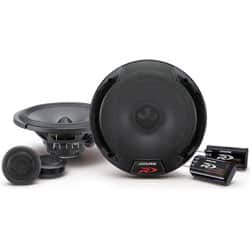
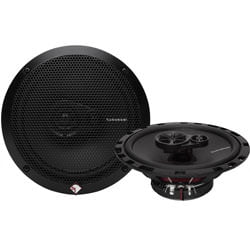
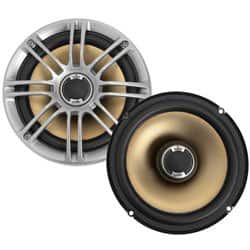
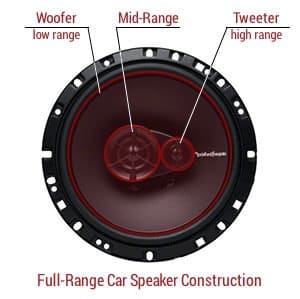
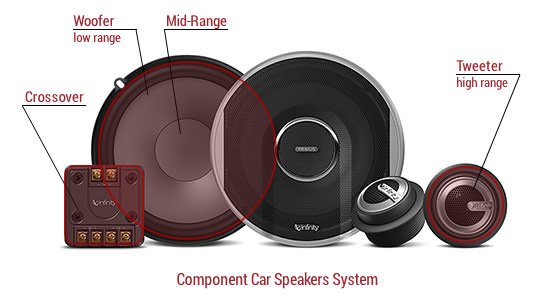
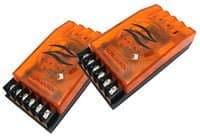 Some full range speakers will simply run a wire to each part of the speaker and they will all try to make the full range of sounds. This means that your tweeters will be putting out some bass and the woofer will be putting out some of the high end. Frankly, they won’t do a great job at it.
Some full range speakers will simply run a wire to each part of the speaker and they will all try to make the full range of sounds. This means that your tweeters will be putting out some bass and the woofer will be putting out some of the high end. Frankly, they won’t do a great job at it.